Kind of Potato Rooster includes a wide range of nutrients, from micronutrients like vitamins and minerals to macronutrients like proteins and carbohydrates. You may be surprised to learn about the impressive amounts of vitamin C, potassium, and dietary fiber they contain.
Let’s explore seven key nutrition parameters associated with potatoes, shedding light on their composition and how they contribute to our health!
Contents
Rooster Potatoes
Rooster potatoes typically have a medium to tall height plant with thick stems that produce flowers in shades of red or violet. These flowers add a pop of color to the potato plants and can be quite attractive.
- Rooster potatoes are celebrated for their eye-catching appearance, with their distinct earthy and nutty flavor profile.
- They strike a delicate balance between starchy and waxy, making them suitable for a wide range of culinary creations.
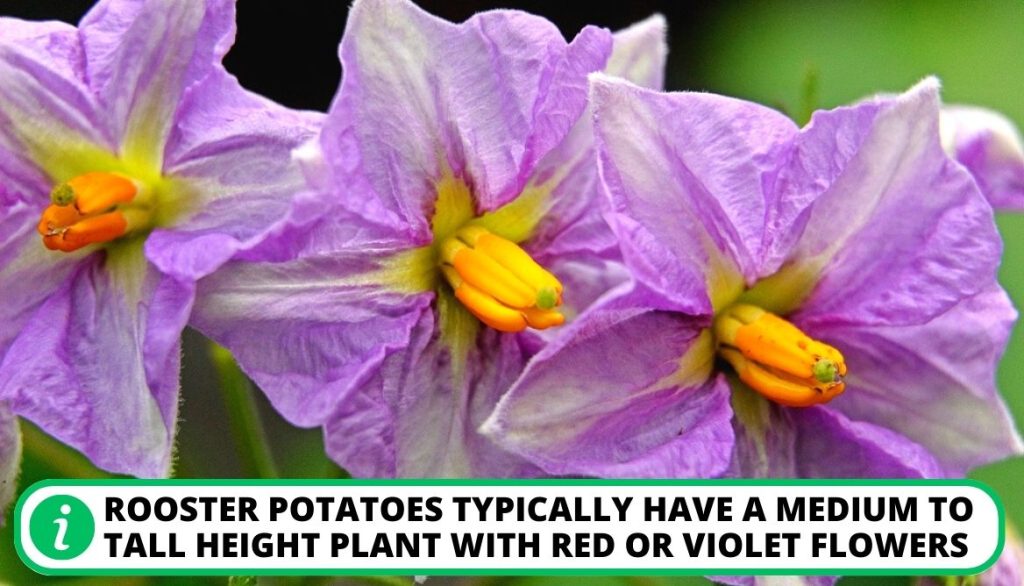
Nutritional Values of Rooster Potatoes
Rooster offers impressive nutritional value, being a good source of dietary fiber, vitamins, and minerals. Rooster potatoes provide a moderate amount of calories and are relatively low in fat. These potatoes also contain essential vitamins and minerals, with notable amounts of vitamin C, potassium, vitamin B6, and iron.
- Vitamin C is known for its antioxidant properties and its role in supporting the immune system.
- Potassium is important for maintaining proper heart and muscle function, while vitamin B6 contributes to brain development and function.
- Iron is essential for red blood cell production and oxygen transport in the body.
Nutrition Table
Nutrient | Amount per 100g |
Calories | 77 kcal |
Carbohydrates | 17.5 g |
Protein | 2 g |
Fat | 0.1 g |
Fiber | 2.2 g |
Vitamin C | 24 mg |
Potassium | 429 mg |
Vitamin B6 | 0.3 mg |
Iron | 1.2 mg |
Potato Variety Rooster and 9 Important Things to Learn about Them
Rooster potatoes belong to the maincrop maturity potatocategory which is harvested later in the year and usually has higher yields. This table summarises the potato characteristics we would be explaining below.
Property | Description |
Variety Name | Rooster |
Owner | TEAGASC |
Origin | 2 g |
Inception Year | 1991 |
Maturity | Late |
Skin Color | Dull red-skinned |
Flesh Color | Yellow |
Shape | Oval |
Texture | Firm, waxy |
Flavor | Earthy, nutty |
Yield | High |
Disease Resistance | Higher resistance to common scab, powdery scab, and potato viruses |
Storage | Good storage ability |
Culinary Rating and use | Excellent taste, Roasted steamed, and baked |
So, let us discuss the features extensively below.
1. Origin
The Rooster potato variety originated in Ireland. It was first developed by the Irish Agriculture and Food Development Authority (Teagasc) and was released in 1991.
2. Productivity
Rooster potatoes are known for their high yield potential. They typically produce potatoes of medium-smooth to large-sized ones. The dry matter capable content of the potatoes is relatively high, which means they have a dense and firm texture when cooked.
3. Versatile Cooking Applications
Rooster potatoes are highly regarded as general-purpose potatoes, they have a distinct flavor and a creamy texture. They are useful for mashed chipped roasted steamed recipes. These potatoes have low to medium dry matter, and a higher water content, resulting in a softer and moister texture when cooked.
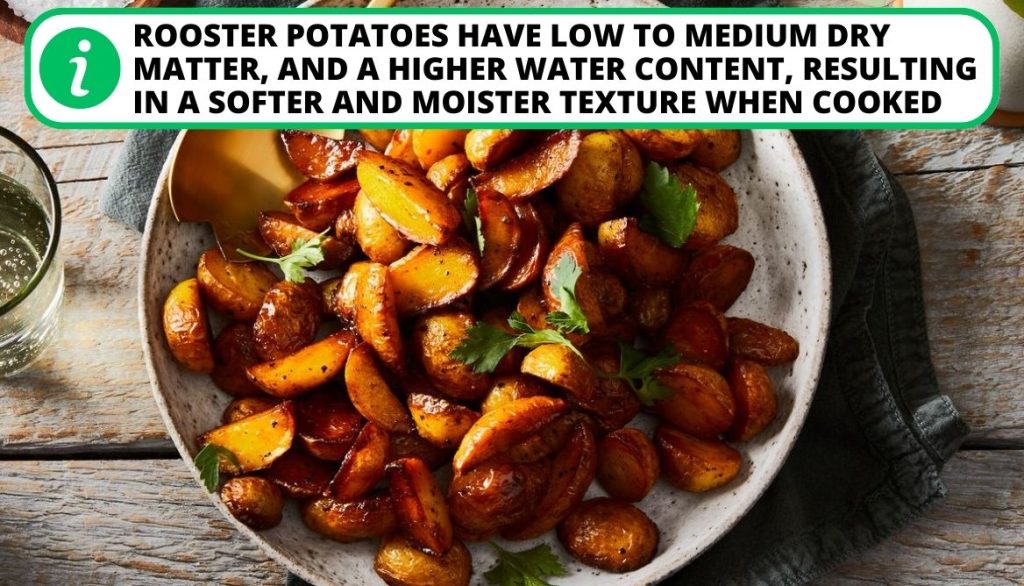
4. Appearance
Rooster potatoes are a variety of uniform-shaped potatoes oval-slightly round potatoes that possess potato characteristics large in size. Their deep dull red skin with yellow flesh adds to their unique appearance.
5. Foliage
The plants of the Rooster potato variety have a semi-upright growth habit. They produce medium-sized foliage with dark green leaves. Rooster potatoes are typically grown as maincrop potatoes, taking around 110-120 days to mature after planting.
6. Defenses Against Diseases
The potatoes exhibit medium resistance to high resistance to common scabs, powdery scabs, blackleg, Potato Leafroll Virus, and late blight on tubers. However, these potatoes have a low resistance to Potato Cyst Nematode.
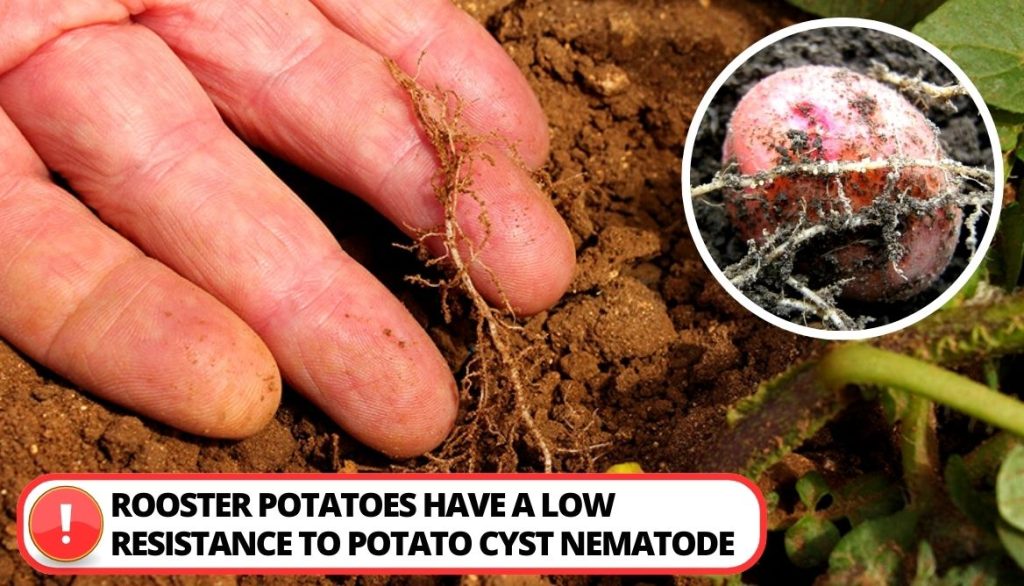
7. Resistance to Pests
These potatoes are not specifically bred for resistance to pests. They may be susceptible to pests such as potato tuber moths, potato aphids, and potato flea beetles.
8. Durability During Handling and Storage
Rooster potatoes have relatively good resistance to mechanical damage during harvesting and handling. The thin but sturdy skin helps protect the tubers from bruising and cuts.
9. Preservation
Rooster potatoes can be preserved by storing them in a cool, dark, and well-ventilated place. Avoid exposing them to direct sunlight, as it can cause greening and spoilage.
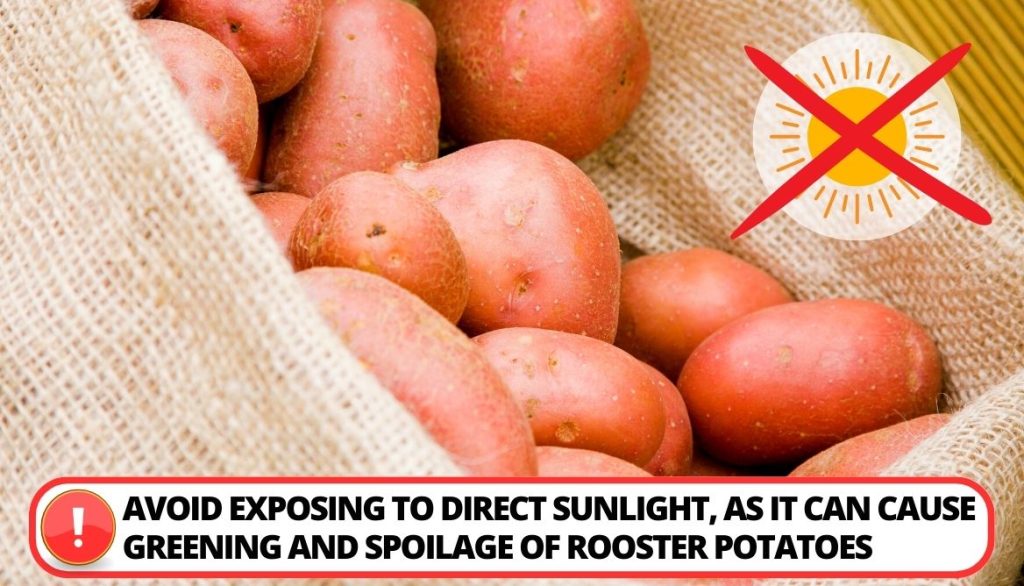
How to Plant Rooster Potatoes
To grow Rooster potatoes, start by selecting certified seed potatoes of the Rooster variety. Allow them to sprout for 4-6 weeks before planting.
- Prepare the planting area by loosening the soil and removing any weeds or debris.
- Plant the sprouted seed potatoes with the sprouts facing up, about 12-15 inches apart, and 3-4 inches deep.
- Keep the soil consistently moist but not waterlogged as the plants grow.
- Mound up soil around the thick stems or base of the plants to promote tuber development and protect them from sunlight.
- Apply a balanced fertilizer or compost at planting time and consider additional fertilization during the growing season.
- Monitor the plants for pests and diseases and take appropriate control measures if needed.
- Harvest the potatoes when the foliage turns yellow and starts to die back.
- Allow them to dry on the soil surface before splitting storage rooster potatoes or use.
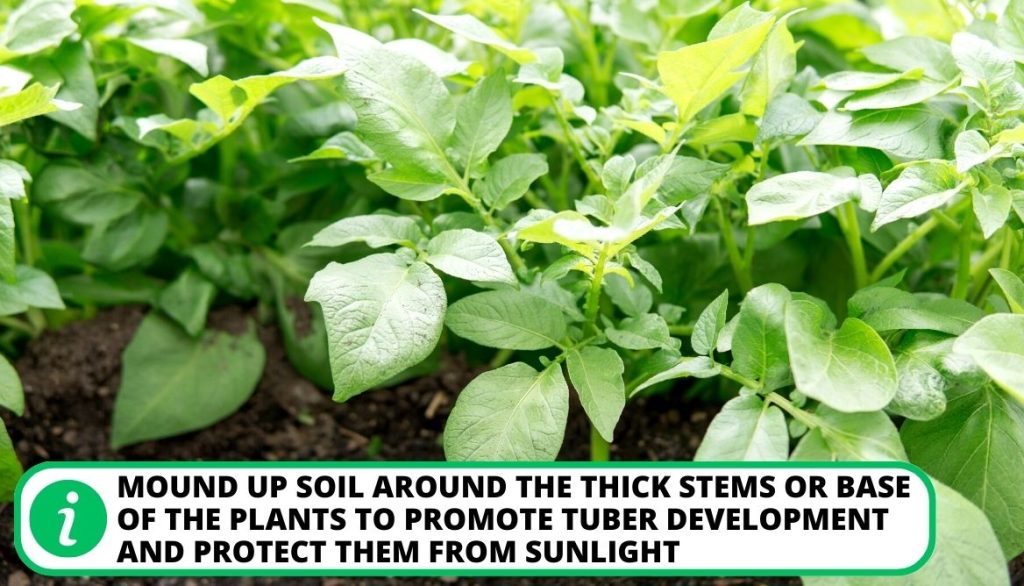
Our Verdict – Are Rooster Potatoes Good to Use?
Rooster potatoes are a reliable and valuable choice that deserves a place in your kitchen. Not only do they offer a delicious earthy and nutty flavor, but they also provide a range of essential nutrients:
- High vitamin C content,
- Potassium,
- Dietary fiber,
- Other vitamins and minerals.
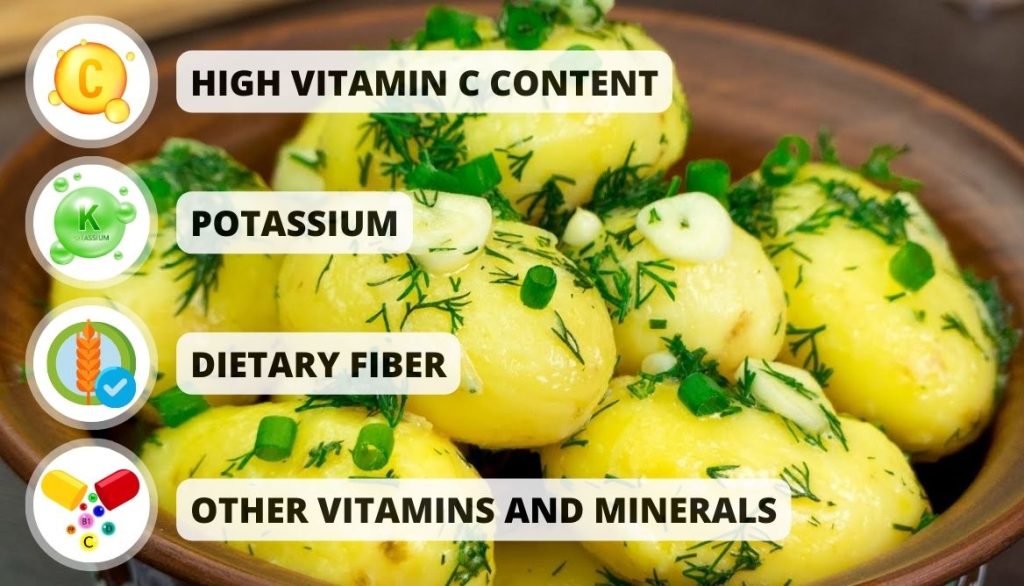
FAQ
Is there a potato called Rooster?
Yes, there is a potato variety called Rooster. It is a well-known and popular type of potato.
Where are Rooster potatoes grown?
Rooster potatoes are grown in various regions due to their popularity but originated in Ireland.
Do Rooster potatoes store well?
Rooster potatoes have good storage capabilities when stored under proper conditions. They can maintain their quality and freshness for a relatively long period.
Is Rooster a floury potato?
Yes, Floury potatoes have a higher starch content and a drier texture, making them ideal for mashed roasted steamed, and baked.
Are Rooster potatoes healthy?
Yes, they are healthy. they are a good source of dietary fiber, vitamins C and B6, and potassium.
Conclusion
Rooster potatoes are a popular and versatile variety known for their deep dull red-skinned. Their delicious taste, versatile culinary applications, resistance to pests and diseases, and nutritional value make them an excellent option for growing and creating flavorful meals.
Have you ever tried Rooster potatoes in your cooking? Leave your answer in the comment section. Thanks for reading.
- How to Get Potatoes to Sprout Eyes: Detailed Growing Guide with 3 Options - July 31, 2023
- Weight of a Medium Potato: Revealed in Detailed Guide - July 29, 2023
- Maris Piper Potatoes: 9 Substitutes You Should Know About - July 27, 2023
Hello! I’m Jessica Zander, a garden coach and consultant based in the Boston area (zone 6b), offering virtual consultations across the country and Canada.
I’ve been passionate about gardening since the early 1990s, and in 2022, I launched You Can Do It Gardening to empower individuals to feel more confident in their gardening endeavors.
Following a 30-year career in nonprofit finance and operations, I transitioned out of that field in mid-June of 2023 due to the growing demand for coaching services. Interestingly, my years of presenting financial statements to boards and finance committees proved to be valuable experience for teaching people about gardening! I enjoy sharing skills, providing guidance and suggestions, and collaborating efficiently with clients to make significant improvements to their outdoor spaces, both small and large. I also regularly teach at the Arlington Continuing Education and Cambridge Adult Education.
My approach is direct and practical, akin to Mary Poppins, but tailored to your garden. Clients find satisfaction in saving money and taking pride in their own gardening achievements.

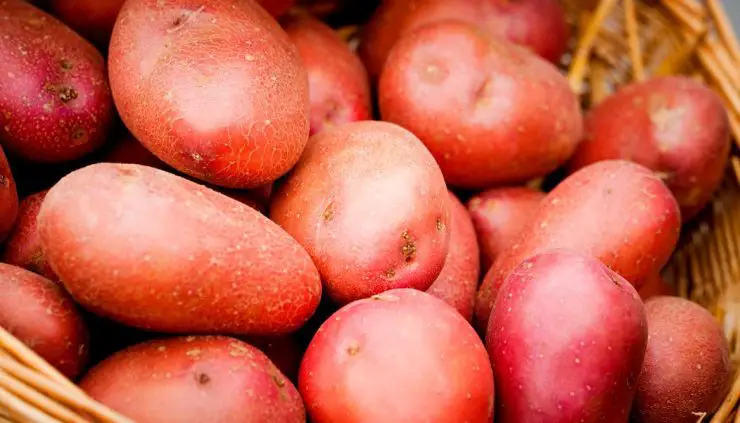
Add comment